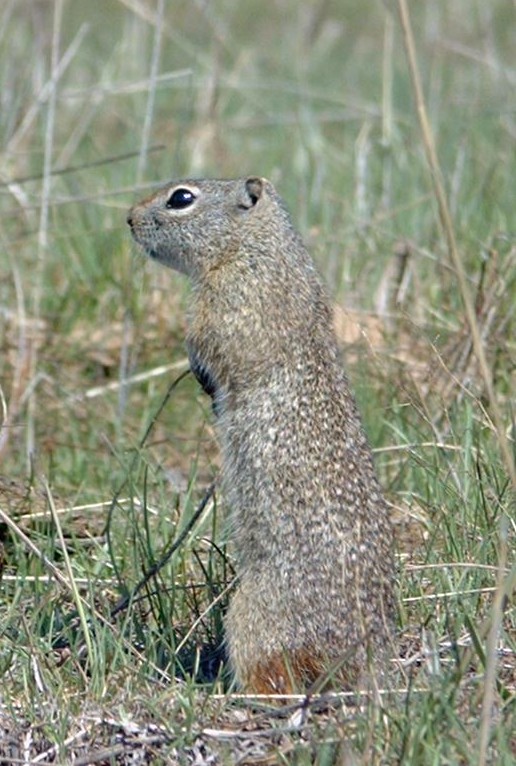SAVE THE NORTHERN IDAHO GROUND SQUIRREL!
Julian Lohser
 |
| The northern Idaho ground squirrel[1] |
About
The northern Idaho ground squirrel (Spermophilus brunneus brunneus) is a smaller member of the squirrel
family. The fur on the dorsal area is dark reddish-gray, with a buffy white eye
ring. It has one of the smallest geographic ranges of any North American
mammal.
This squirrel occupies meadow habitats that are bordered by
pine forests. Their primary diet consists of seeds of forbs, lupines, and
composites. The grasses and seeds are especially important, because the
northern Idaho ground squirrel uses these to store energy for the winter.
The northern Idaho ground squirrel emerges in late March,
and is active until early August. They are sexually mature the first spring
after their birth, and are reproductively active within 2 weeks of emergence. Males
tend to die at a younger age, due to the long distances traveled to find
receptive females and fights with other males over the females.
Geographic and
Population Changes
The northern Idaho ground squirrel is found in fragmented
populations in the Adams and Valley counties of west-central Idaho. They prefer open meadow areas that also have a low density of coniferous trees[2]. Habitat
fragmentation has led to smaller, isolated squirrel populations that are prone
to extinction due to naturally occurring factors. In 1985, the population of
squirrels was approximately 5000. A 2002 estimate showed approximately 450 to
500 squirrels remaining.
 |
| The small geographic range the northern Idaho ground squirrel occupies[2]. |
Listing Date and Type
of Listing
On April 5, 2000, the northern Idaho ground squirrel was
federally listed as a threatened species.
Cause of listing and
Main threats to its continued existence
Habitat loss threatens the northern Idaho ground squirrel
due to forest encroachment causing habitat fragmentation. Fire exclusion and
the dense regrowth of conifers from past logging activities are significantly
reducing suitable meadow habitats. This has led to the reduction in dispersal
corridors, further isolating the species. It is also threatened by land use changes,
recreational shooting, poisoning, genetic isolation, and competition from the
larger Columbian ground squirrel. Badgers are also an efficient predator that can wipe out smaller populations of squirrels in just a few days[4].
| Badgers easily overpower ground squirrels.[5] |
Description of
Recovery Plan[4]
The northern Idaho ground squirrel has a recovery priority
number of 3C assigned to it. This comes from a scale of 1-18, where 1
represents the highest priority for recovery. Also, it means that the northern
Idaho ground squirrel is a subspecies facing a high degree of threat, but have
a high potential for recovery.
The recovery criteria include an effective population size
of greater than 5000 individuals. There must be at least 10 metapopulations
that each maintain an average effective population size of greater than 500
individuals for 5 consecutive years. The area of the 10 metapopulations must be
protected, whether by government agency or agreement with landowners.
The steps to recovery
are:
1. Restore and Maintain Habitat – Create site
specific habitat management plans. Thin and burn the habitat, and reseed with
native grass and forb species. Appropriate habitat must be maintained with
prescribed burning and vegetation management.
2. Conduct Population Actions – Translocation of the squirrel to increase genetic diversity, combined with a captive breeding program to offset the high loss of the translocation, followed by reintroduction within the probable historic distribution. Further research must be done on habitat, ecology, and genetics.
2. Conduct Population Actions – Translocation of the squirrel to increase genetic diversity, combined with a captive breeding program to offset the high loss of the translocation, followed by reintroduction within the probable historic distribution. Further research must be done on habitat, ecology, and genetics.
3. Monitor Habitat and Populations – Better methodologies
to survey the population of squirrels must be standardized. The effects of
vegetative treatments will be monitored as well.
4. Coordinate the Recovery Program – Establish a coordinator, working group, public outreach program, and central database.
4. Coordinate the Recovery Program – Establish a coordinator, working group, public outreach program, and central database.
What can you do?
Write! E-mail or send a letter to any mayor in Adams County, Idaho or Valley County and let them know how much the northern Idaho ground squirrel means to you!
Other resources
Works Cited
1. "Northern Idaho Ground Squirrel (Urocitellus Brunneus)." Northern Idaho Ground Squirrel (Urocitellus Brunneus) | Species. N.p., n.d. Web. 28 Nov. 2016.
2. Service, U.S. Fish and Wildlife. "Species Profile for Northern Idaho Ground Squirrel (Urocitellus Brunneus)." Species Profile for Northern Idaho Ground Squirrel (Urocitellus Brunneus). N.p., n.d. Web. 28 Nov. 2016. <https://ecos.fws.gov/ecp0/profile/speciesProfile?spcode=A0EK>.
3. SURONEN, ELISE F., and BETH A. NEWINGHAM. "A Starting Point: An Ecosystem Of Reference For Habitat Restoration Of The Northern Idaho Ground Squirrel, Urocitellus Brunneus Brunneus." Northwestern Naturalist 94.2 (2013): 110-125. Academic Search Premier. Web. 28 Nov. 2016.
4. U.S. Fish and Wildlife Service. 2003. Recovery Plan for the Northern Idaho
Ground Squirrel (Spermophilus brunneus brunneus). Portland, Oregon. 68 pp.
5. Rolf Nussbaumer Photography, 2323 Bretzke Lane, New Braunfels, TX 78132, USA, Www.rolfnp.com, Tel. 210 643 4800. "AMBA_027234.jpg." Premium Nature Images. N.p., n.d. Web. 28 Nov. 2016. <http://rolfnussbaumer.photoshelter.com/image/I0000rOv5UJ7ocRY>.
Kate Lovsted: Good information about the species (description of the animal, where it lives, what it eats, etc.). Very helpful to have a map of the geographic changes, and it makes a great impact on seeing how endangered this species is since the area is so small. Could go into more detail about the causes of listing, rather than just listing these reasons off (could explain why these reasons lead to extinction and how they affect the species). Could go into more detail about the Recovery Plan, as well as the "What Can You Do?" section. More pictures and maps!!! Overall good information, though!
ReplyDelete